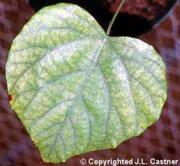

Common Names: Curare,
Grieswurzel, Pareira Brava, Pareira, Vigne Sauvage
Genus: Chondrodendron
Species: tomentosum
Parts Used: Leaf, Root

Curare grows as a large liana, or vine, found in the canopy of the South American rainforest. The vine may get as thick as 4 inches in diameter at its base. It has large alternate, heart-shaped leaves which may be 4-8 inches long and almost as wide, with a 2-6 inches long petiole. The leaves are smooth on top with a hairy white bottom, and deeply indented veins radiating from the leaf base. Clusters of small (1/16-1/8 inches), greenish-white flowers are made up of separate male and female flowers. The fleshy fruits are oval, narrow at the base, and approximately 1-2 mm long.
Some Indians of South America crush and cook the roots and stems, and add other plants and venomous animals, mixing it until it becomes a light syrup. They call this mixture "ampi", or "curaré", which they use on the tip of their arrows and darts to hunt wild game. Crude curare is a dark brown or black mass with a sticky to hard consistency and an aromatic, tarry odor. The name comes from Indian word meaning "poison."
The active ingredient in "curaré", D-tubocurarine, is used in medicine. Brazilians consider the root a diuretic, and use it internally in small quantities for madness and dropsy, and externally for bruises. It is also used for edema, fever, and kidney stones.
Curare is an alkaloid, and acts as a neuromuscular blocking agent to produce paralysis in muscles. It first affects the muscles of the toes, ears, and eyes, then those of the neck, arms and legs, and finally, those involved in breathing. In fatal doses, death is caused by respiratory paralysis. Curare must get into the blood system for it to work. It doesn't hurt to eat something killed by a poisoned curare arrow, for instance.
Geographic Location: Amazon Basin of South America.
2000
Bibliography:
"Curare", http://www.botgard.ucla.edu/html/botanytextbooks/economicbotany/Curare/
"Curare", http://peace.saumag.edu/faculty/Kardas/Courses/GPWeiten/C3BioBases/Curare.html
"King's American Dispensatory: Curare" http://www.ibiblio.org/herbmed/eclectic/kings/curare.html